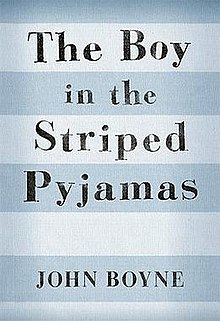The novel “The Boy in the Striped Pyjamas” by John Boyne portrays the innocent mind of a German boy called Bruno who relocates from an ideal wealth of life in Germany to a house next to the Concentration Camp of Auschwitz where his father has been chosen to work as a Nazi commander.
Boyne produces historical acknowledgments through his narrative style. He does this by using boundaries, friendship, innocence & ignorance, equality, perspective, the illusion of transparency, and a bond that beats racial discrimination.
Using Boyne’s narrative technique, he can develop the reader’s empathy and emotion towards Bruno and Shmuel, the terrors of the Holocaust, and the innocence between the two boys while showing humans’ capacity for inhumanity and indifference by distorting his composition in order to reveal.
In the novel, innocence and ignorance are shown especially through Bruno, likewise for Shmuel. Both the boys were almost jealous about each other’s sides, but curious as well. By the way, Bruno says “It’s so unfair.
I don’t see why I should be stuck on this side of the fence where there’s no one to talk to and no one to play with, and you get to have dozens of friends and are probably playing for hours every day…”, it is evident to the reader that he hasn’t the faintest clue about the Holocaust and the severity of the situation.
Shmuel acts in the same way, accepting the circumstances as common. Another point is that ignorance is shown as well. For example, neither of them asks about each other’s lives and/or the way they are feeling, especially Bruno, giving him the illusion of transparency. This is a psychological term meaning that Bruno believes he knows the way Shmuel is feeling and it mixes in with both innocence and ignorance.
The way that Bruno and Shmuel experience innocence while using the third-person perspective gives the readers a sense of dramatic irony knowing what is happening in place of the boys’ notions. It shows two different perspectives at the same time; a child’s and an adult’s. This shows that innocence and ignorance have a significant impact on the characters and creates a clearer understanding of dramatic irony.
One of the most important themes in the novel is boundaries. There are two kinds; literal and figurative. One of the literal boundaries includes the fence. This separated Bruno and Shmuel and is how Bruno found Shmuel while exploring. It is a significant part of the book.
Another literal example is his father’s office, also referred to as “Out of Bounds At All Times and No Exceptions”. By the way, capitalization is shown, Bruno must have this said to him by one of his family members often. Another type of boundary is a figurative boundary, which, unlike a literal boundary, it isn’t physically there.
A prime example is innocence in general and social segregation. It is something that is slowly overcome but is always going to be there, as nobody knows everything. It is therefore evident that there are boundaries and segregation throughout the book.
Friendship is a constant theme in The Boy in the Striped Pyjamas. It all begins when Bruno spots Shmuel’s differences, for example, “His skin was almost the color of grey, but not quite like any grey that Bruno had ever seen before.
He had very large eyes and they were the colour of caramel sweets; the whites were very white, and when the boy looked at him all Bruno could see was an enormous pair of sad eyes staring back. Bruno was sure that he had never seen a skinnier or sadder boy in his life but decided that he had better talk to him.” Although this would’ve been off-putting for most other nine-year-olds, Bruno still wanted to be kind and said hello.
Soon after, they find they have the same birthday, which makes them feel happy with the discovery that they both made. How could they possibly be so different? They were “nearly twins”. This friendship continues because of their consideration of each other’s opinions. There is a sense of equality that comes with the friendship as well.
The fact that both Bruno and Shmuel share the same birthday uses the symbolism of equality between the two, as well as their gender. This then is trivialised when the audience realises the racism behind it. It symbolises that two boys of the same gender and age have so very different lives all depending on their race, which they cannot change, and their friendship is a symbol of equality, and that it isn’t impossible to like someone even though the rest of society doesn’t.
It is evident that the theme of friendship is involved and how the theme of equality among the races is shown.
From what is pointed out, it can be concluded that the themes of boundaries, friendship, innocence and ignorance, equality, perspective, and illusion of transparency are shown, as well as further racial discrimination. The book is a heart-warming one and the ending will leave readers stunned. Boyne’s use of narrative technique ensures that you become endeared by the characters and reveals his morals very dynamically.



Awesome!
I love it, if I were a billionaire, I would give a billion as gratitude. Keep doing what you do.
Good work!!